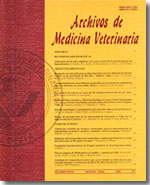Relationships between ante-mortem handling, blood based stress indicators and carcass pH in steers
Main Article Content
Abstract
The relationship between blood variables indicating stress in steers before slaughter and variables that indicate quality of the meat was studied, using data taken from 420 Friesian steers of the same origin, age and weight that had been transported for 3, 6, 12,16 or 24 hours, had 3, 6, 12 or 24 hours of lairage before slaughter, and had been slaughtered either in summer (fed with pasture) or in winter (fed with grass silage and grain). Blood samples were collected at the farm before transport to the slaughter house in order to determine packed cell volume (PCV), concentrations of glucose, ß-hidroxibutirate, cortisol, and plasmatic activity of creatinfosfokinase (CK). After slaughter, liver and muscle glycogen concentrations were determined and carcass pH was measured 24 hours post-mortem. The plasmatic activity of CK in blood collected before transport was the only variable that was significantly different between steers that produced carcasses with pH < 5.8 (normal) and pH ≥ 5.8. The glucose and PCV values obtained from samples taken at the farm showed a low (< 50%) but significant correlation with pH value. A logistic regression showed that transport times ≥ 16 hours and fasting times ≥ 24 hours increase the probability of having meat with pH ≥ 5.8. Steers slaughtered in summer had a higher risk of presenting carcasses with pH = 5.8 than those slaughtered in winter. It was concluded that it is not possible to predict the occurrence of carcasses with pH ≥ 5.8 based on blood profiles of steers taken at the farm, but according to the logistic regression the journey and fasting times before slaughter, as well as slaugthering season, were preponderant factors in the occurrence of carcasses with pH ≥ 5.8.

